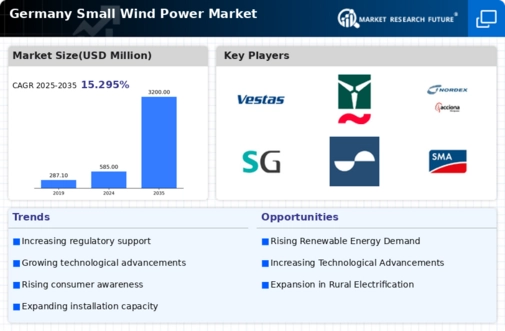The small wind-power market in Germany is characterized by a dynamic competitive landscape, driven by increasing demand for renewable energy solutions and supportive government policies. Key players such as Siemens Gamesa (DE), Enercon (DE), and Nordex (DE) are at the forefront, each adopting distinct strategies to enhance their market presence. Siemens Gamesa (DE) focuses on innovation and technological advancements, particularly in turbine efficiency and digital solutions, which positions it as a leader in the sector. Enercon (DE), on the other hand, emphasizes local manufacturing and sustainability, aligning its operations with Germany's stringent environmental regulations. Nordex (DE) is actively pursuing regional expansion, particularly in underserved markets, thereby diversifying its portfolio and customer base. Collectively, these strategies contribute to a moderately fragmented market structure, where competition is shaped by technological prowess and regional adaptability.
In terms of business tactics, companies are increasingly localizing manufacturing to reduce costs and enhance supply chain efficiency. This approach not only mitigates risks associated with global supply chains but also aligns with the growing consumer preference for locally sourced products. The competitive structure remains moderately fragmented, with several players vying for market share, yet the influence of major companies is palpable, as they set benchmarks for innovation and operational excellence.
In October 2025, Siemens Gamesa (DE) announced a partnership with a leading German utility company to develop a new line of small wind turbines tailored for urban environments. This strategic move is significant as it addresses the growing need for renewable energy solutions in densely populated areas, potentially opening new revenue streams and enhancing the company's market position. The collaboration underscores Siemens Gamesa's commitment to innovation and its responsiveness to emerging market demands.
In September 2025, Enercon (DE) unveiled a new manufacturing facility in Germany, aimed at increasing production capacity for small wind turbines. This investment reflects Enercon's strategy to bolster local manufacturing capabilities, thereby reducing lead times and enhancing supply chain reliability. The facility is expected to create numerous jobs and further solidify Enercon's role as a key player in the domestic market.
In August 2025, Nordex (DE) secured a significant contract for the supply of small wind turbines to a consortium of local municipalities. This contract not only reinforces Nordex's commitment to regional expansion but also highlights the growing trend of community-driven renewable energy projects. By engaging with local stakeholders, Nordex is likely to enhance its brand loyalty and market penetration.
As of November 2025, the competitive trends in the small wind-power market are increasingly defined by digitalization, sustainability, and the integration of AI technologies. Strategic alliances are becoming more prevalent, as companies recognize the value of collaboration in driving innovation and enhancing operational efficiencies. Looking ahead, competitive differentiation is expected to evolve, shifting from traditional price-based competition to a focus on technological innovation, reliability of supply chains, and sustainable practices. This transition may redefine market dynamics, compelling companies to invest in R&D and forge strategic partnerships to maintain a competitive edge.


















Leave a Comment